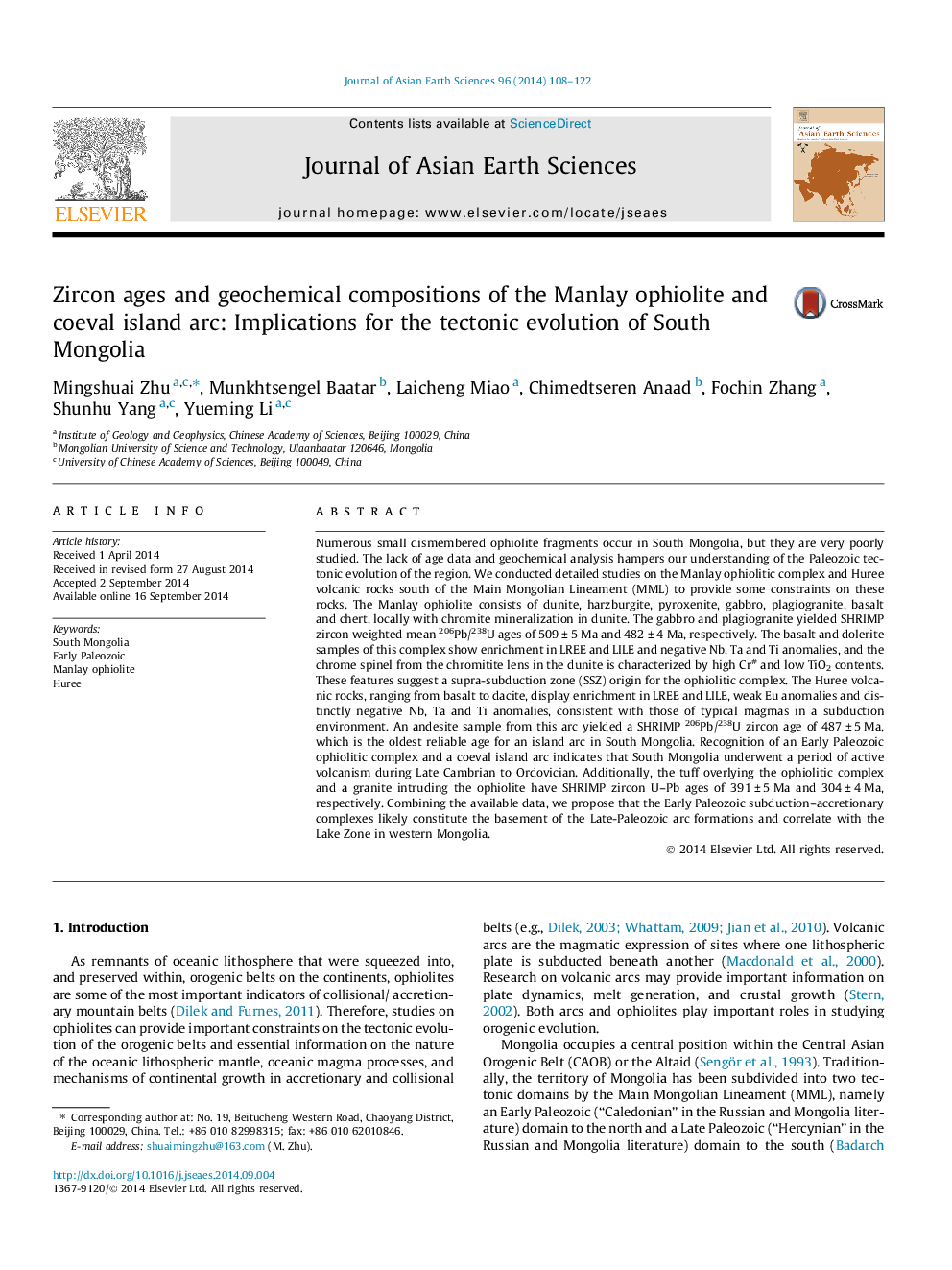| کد مقاله | کد نشریه | سال انتشار | مقاله انگلیسی | نسخه تمام متن |
|---|---|---|---|---|
| 6444299 | 1640372 | 2014 | 15 صفحه PDF | دانلود رایگان |
عنوان انگلیسی مقاله ISI
Zircon ages and geochemical compositions of the Manlay ophiolite and coeval island arc: Implications for the tectonic evolution of South Mongolia
ترجمه فارسی عنوان
سنین پیرسون و ترکیبات ژئوشیمیایی افیولیت مانیل و قوس جزیره همسایه: پیامدهای تکامل تکتونیکی مغولستان جنوبی
دانلود مقاله + سفارش ترجمه
دانلود مقاله ISI انگلیسی
رایگان برای ایرانیان
کلمات کلیدی
مغولستان جنوبی، اولیه پالئوزوئیک، مانلیو افیولیت، هیور،
موضوعات مرتبط
مهندسی و علوم پایه
علوم زمین و سیارات
زمین شناسی
چکیده انگلیسی
Numerous small dismembered ophiolite fragments occur in South Mongolia, but they are very poorly studied. The lack of age data and geochemical analysis hampers our understanding of the Paleozoic tectonic evolution of the region. We conducted detailed studies on the Manlay ophiolitic complex and Huree volcanic rocks south of the Main Mongolian Lineament (MML) to provide some constraints on these rocks. The Manlay ophiolite consists of dunite, harzburgite, pyroxenite, gabbro, plagiogranite, basalt and chert, locally with chromite mineralization in dunite. The gabbro and plagiogranite yielded SHRIMP zircon weighted mean 206Pb/238U ages of 509 ± 5 Ma and 482 ± 4 Ma, respectively. The basalt and dolerite samples of this complex show enrichment in LREE and LILE and negative Nb, Ta and Ti anomalies, and the chrome spinel from the chromitite lens in the dunite is characterized by high Cr# and low TiO2 contents. These features suggest a supra-subduction zone (SSZ) origin for the ophiolitic complex. The Huree volcanic rocks, ranging from basalt to dacite, display enrichment in LREE and LILE, weak Eu anomalies and distinctly negative Nb, Ta and Ti anomalies, consistent with those of typical magmas in a subduction environment. An andesite sample from this arc yielded a SHRIMP 206Pb/238U zircon age of 487 ± 5 Ma, which is the oldest reliable age for an island arc in South Mongolia. Recognition of an Early Paleozoic ophiolitic complex and a coeval island arc indicates that South Mongolia underwent a period of active volcanism during Late Cambrian to Ordovician. Additionally, the tuff overlying the ophiolitic complex and a granite intruding the ophiolite have SHRIMP zircon U-Pb ages of 391 ± 5 Ma and 304 ± 4 Ma, respectively. Combining the available data, we propose that the Early Paleozoic subduction-accretionary complexes likely constitute the basement of the Late-Paleozoic arc formations and correlate with the Lake Zone in western Mongolia.
ناشر
Database: Elsevier - ScienceDirect (ساینس دایرکت)
Journal: Journal of Asian Earth Sciences - Volume 96, 15 December 2014, Pages 108-122
Journal: Journal of Asian Earth Sciences - Volume 96, 15 December 2014, Pages 108-122
نویسندگان
Mingshuai Zhu, Munkhtsengel Baatar, Laicheng Miao, Chimedtseren Anaad, Fochin Zhang, Shunhu Yang, Yueming Li,
